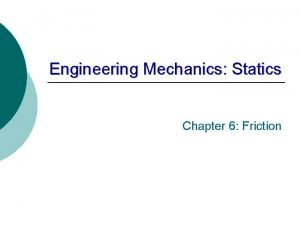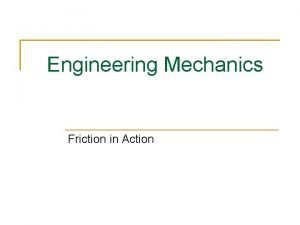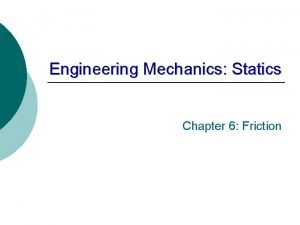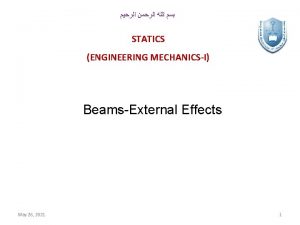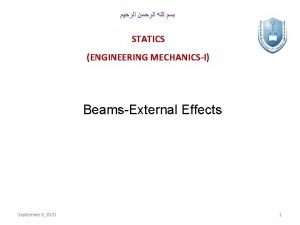STATICS ENGINEERING MECHANICSI Friction March 10 2021 1
















- Slides: 16

ﺑﺴﻢ ﺍﻟﻠﻪ ﺍﻟﺮﺣﻤﻦ ﺍﻟﺮﺣﻴﻢ STATICS (ENGINEERING MECHANICS-I) Friction March 10, 2021 1

Friction • Friction is a force that resists the movement of two contacting surfaces that slide relative to one another. • This force always acts tangent to the surface at the points of contact. • Friction force is directed to oppose the possible or existing motion between the surfaces. 3/10/2021 2

Types of Friction – Dry Friction: Dry friction is encountered when two un-lubricated surfaces of two solids are in contact under a condition of sliding or tendency to slide. – Fluid Friction: Fluid friction is developed when adjacent layers in a fluid (liquid or gas) are moving at different velocities. – Internal Friction: Internal friction is found in all solid materials that are subjected to cyclic loading. For highly elastic materials the recovery from deformation occurs with very little loss of energy caused by internal friction. 3/10/2021 3

Dry Friction Mechanism of Friction • The contacting surfaces possess a certain amount of roughness. • The experiment will involve the application of a horizontal force P which will vary continuously from zero to a value sufficient to move the block and give it an appreciable velocity. 3/10/2021 4

Dry Friction (Contd. ) • The region up to the point of slippage or impending motion is known as the range of static friction, and the value of the friction force is determined by the equations of equilibrium (thus, F = P). • The maximum value of static friction Fmax is proportional to the normal force N. Therefore 3/10/2021 5

Variation of Friction Force For a condition of static equilibrium when motion is not impending: After slippage occurs, a condition of kinetic friction accompanies the ensuing motion. Kinetic friction force is somewhat less than the maximum static friction force. 3/10/2021 6

Kinetic Friction Kinetic friction force is also proportional to the normal force. Hence, As the velocity of the block increases, the kinetic friction coefficient decreases somewhat, and when high velocities are reached, the effect of lubrication by an intervening fluid film may become appreciable The coefficient greatly depends on the exact condition of the surfaces, as well as on the velocity, and are subject to a considerable measure of uncertainty. 3/10/2021 7

Friction Angles: The direction of the resultant R measured from the direction of N. 3/10/2021 8




Problem-1 Determine the maximum angle θ which the adjustable incline may have with the horizontal before the block of mass m begins to slip. The coefficient of static friction between the block and the inclined surface is μs. 3/10/2021 12

Solution 3/10/2021 13

Problem-2 Determine the range of values which the mass m 0 may have so that the 100 -kg block shown in the figure will neither start moving up the plane nor slip down the plane. The coefficient of static friction for the contact surfaces is 0. 30. 3/10/2021 14

Solution Case I: The block tends to move up 3/10/2021 15

Solution (contd. ) Case II: The block tends to move down Thus, m 0 may have any value from 6. 01 to 62. 4 kg, and the block will remain at rest. 3/10/2021 16
 March march dabrowski
March march dabrowski Jack is going skiing
Jack is going skiing Weekly current events quiz
Weekly current events quiz March 5 2021
March 5 2021 Engineering mechanics statics in si units
Engineering mechanics statics in si units Engineering mechanics moment of force problems
Engineering mechanics moment of force problems Friction in engineering mechanics
Friction in engineering mechanics A flat belt connects pulley a to pulley b
A flat belt connects pulley a to pulley b Engineering mechanics (9th) edition chapter 12 problem 30p
Engineering mechanics (9th) edition chapter 12 problem 30p What is system in software engineering
What is system in software engineering Forward engineering in software engineering
Forward engineering in software engineering Engineering elegant systems: theory of systems engineering
Engineering elegant systems: theory of systems engineering Elegant systems
Elegant systems Reverse engineering vs forward engineering
Reverse engineering vs forward engineering Grihalakshmi magazine march 2019
Grihalakshmi magazine march 2019 March 30 1853
March 30 1853 Genetic engineering conclusion
Genetic engineering conclusion






